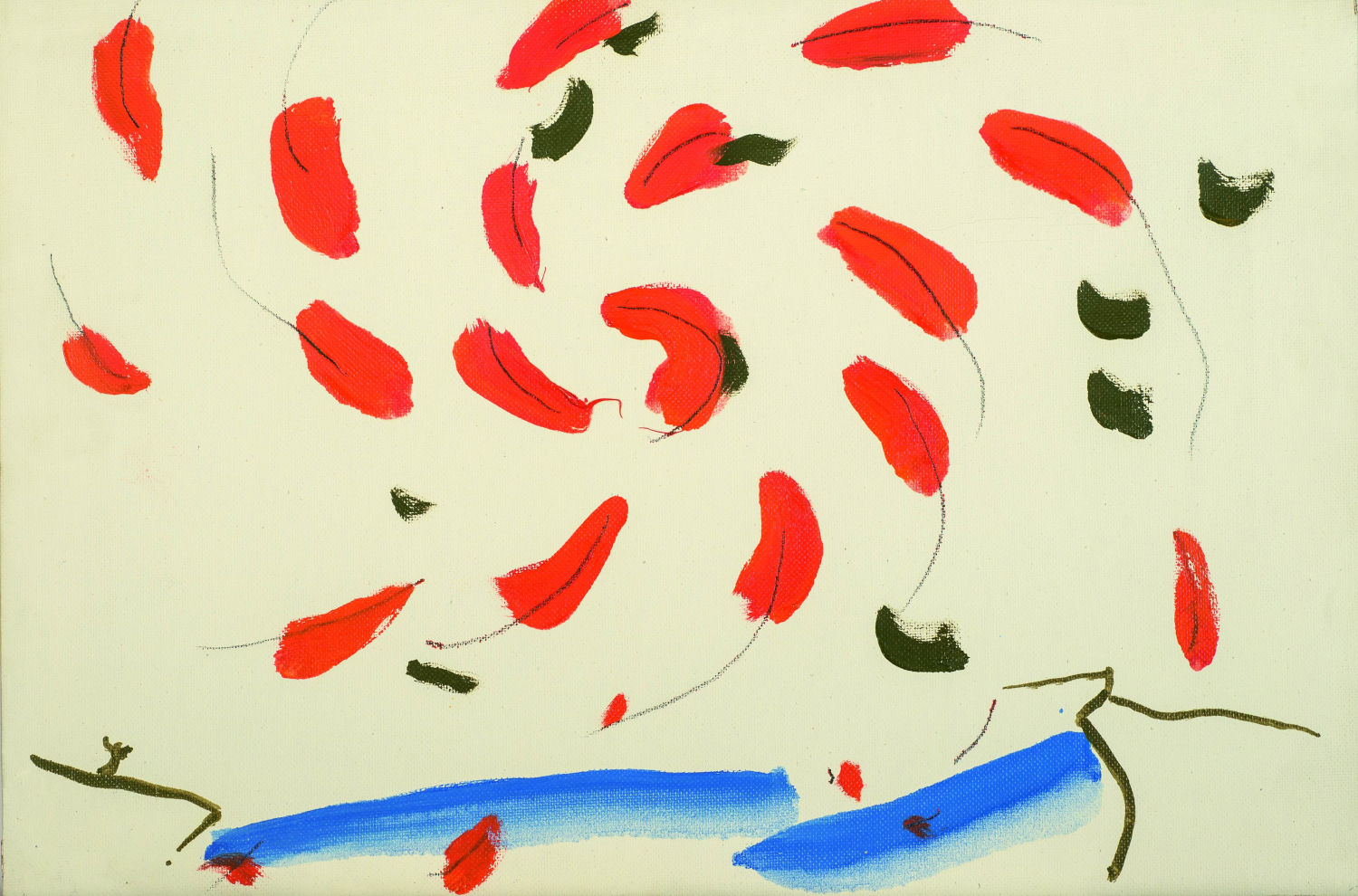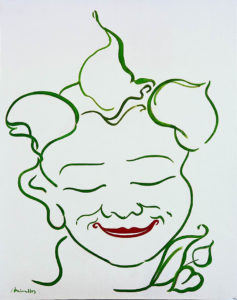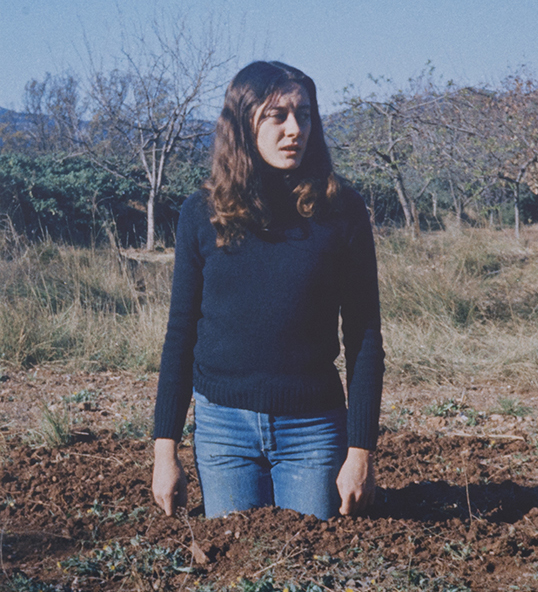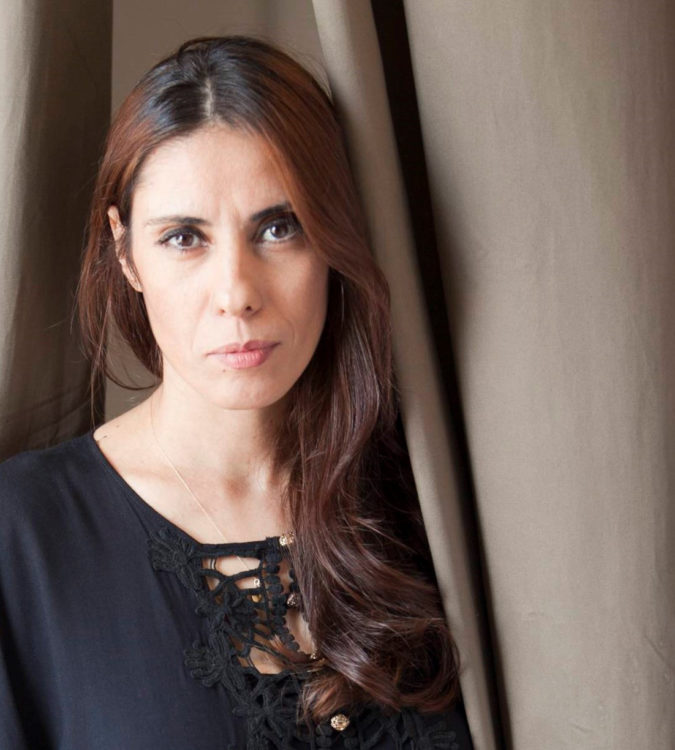Research
Fina Miralles, Los pájaros pierden las plumas cuando llegan al sol [The birds lose their feathers when they reach the sun], 1986, pencil and oil on canvas, 27 x 41 cm, courtesy of the artist ©Fina Miralles
Fina Miralles (born 1950, Sabadell) is internationally known for her work associated with the various streams of Conceptual Art,1 but her broader corpus produced over many decades is currently undergoing reconsideration and rereading. After graduating from art school in 1972, she embarked on a career framed by the Franco dictatorship and the upsurge of an alternative art scene that was both distinctively Catalan and influenced by global Conceptual ideas. For a long time critics tended to analyse her Conceptual work in relation to international formats and idioms such as Land Art, Arte Povera and performance, but recent studies have taken a closer look especially at her 1970s output, taking into account the numerous interviews and self-published essays where she describes her thinking and goals.2 The recent publication of a four-volume collection of her writings,3 with its lucid reflections on her own work and art in general, has had a significant impact on critical and historical studies. These essays demand that we consider her life-long production in its totality, affirming that its meaning has always been derived not from the idioms nor media she employed but her own inner drive. Following this line of argument, here we will focus on the second stage of her creative journey (which we situate between 1984 and 1996, the year in which she considered her life’s work done), a period that so far has received much less critical and academic attention than her Conceptual achievements.
F. Miralles’s practice took a radical turn as a consequence of a trip through South America in late 1983. She spent five months immersed in Inca culture and landscapes from Argentina to Bolivia and Peru. During this time she abstained from writing, drawing and taking photographs. Instead, she concentrated on learning to look, see and feel.

Fina Miralles, El centro es el sol. Memorial [The centre is the sun. Memorial], 1996, oil on canvas, 180 x 180 cm, courtesy of the artist © Fina Miralles
Returning to Barcelona, three words signal the before and after of that journey: love, freedom and painting. Following this three-pointed star she plunged deeply into years of internal, geographic and aesthetic exile, years of silence necessary for a new beginning: “To paint the gaze because it renders the invisible visible – and that invisible is the soul.”4 At that turning point in her life, she wrote, she made a decision to stop being a modern artist, to stop looking towards the future, and instead become an ancient artist. This radical shift is reflected in her contemporaneous writings, drawings and paintings. Between 1984 and 1996 she lived and worked in Paris, Agramunt and Cadaqués (Catalonia), at a distance from what’s called the art system. During these formative years she continued her immersion in indigenous cultures, its forms of spirituality and way of knowledge that can only be learned from life. Her interest in the South American world view became one of the guiding creative principles of her work: “I am abandoning bourgeois culture and embracing indigenous culture. The World Soul, Mother Earth, and the protective and creative Pachamama.”5 In indigenous thought the land is everything: our identity, our connection with our ancestors, and the home and hearth of our entire family, human and non-human alike. It is the origin of all that makes life possible, a sacred gift that does not belong to us.
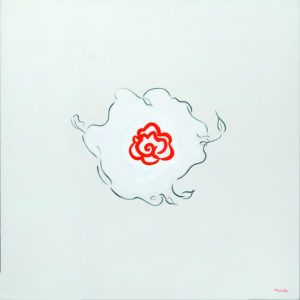
Fina Miralles, El centro es la rosa. Memorial [The centre is the rose. Memorial], 1996, oil on canvas, 146 x 146 cm, courtesy of the artist © Fina Miralles
Underlying her landscapes is the persistence of this sense of belonging to that primeval existence, just as her writing is a cry of alarm in the face of the increasing rationalisation of nature that alienates us from the myth-knowledge at the core of our existence, and which leaves humanity so spiritually impoverished. Her drawings and paintings are populated with symbolic figures and themes such as Lake Titicaca, the island of Amantaní, Machu Picchu, the Urubamba River and the Sacred Tree, as well as sirens and other water creatures, winged beings and mythological figures. Absorbed in an inner voyage to time immemorial and her innermost depths, F. Miralles reinterprets the creative act as a return to the dawn of ancient cultures and millenary truths, celebrating creativity as a sacred gift that moves along the spiral of time, while embracing drawing and writing as means of opening up to the invisible. According to her writings, this new creative process is structured like a ritual. First liberate the hand and the gaze, then liberate thought, intention and the will. Become a receptive channel and let experience change you; become a vector materialising the universal continuum of human knowledge by means of symbolic language and magical thinking.6
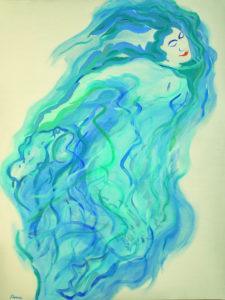
Fina Miralles, El primer baño de la sirena [The first bath of the siren], 1989, oil on canvas, 130 x 97 cm, courtesy of the artist © Fina Miralles
While from indigenous cultures F. Miralles learned a world outlook in which all of Mother Nature’s creatures are endowed with life and are interrelated parts of a sacred whole, the study of Eastern art and philosophy opened the doors of perception to the void and expressive silence. She learned to tune her own heartstrings, let herself be guided, transform the creative act into a temple and thereby enter into harmony with the cosmic order. This meant abandoning the white of paper and canvas as a means of expression or representation and instead feeling the whiteness as a space of the confluence of airy forms, watery currents, cosmic energies, the astral universe, the tree of life, the sacred mountain and the invisible face of birds. She paints not the external appearance of things, but lines that capture the vibrations of matter in its infinite manifestations. She paints the vibration of life itself.
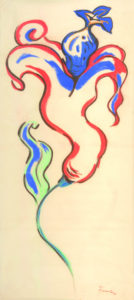
Fina Miralles, Flor [Flower], 1991, pastel on rice paper, 138,2 x 62,5 cm, courtesy of the artist © Fina Miralles
With no studio or other dedicated workspace, F. Miralles draws and writes in that place where, submerged in silence, she opens herself to the void, letting the lines in her drawings become links and manifestations of the three realms of reality: earth, air and starry sky. These three forces, immanent in nature, are the source of her experience and the vital energy of her drawings. In her paintings and drawings, the lines dance, vibrate and become alive in that space. She identifies the movement of her lines as music, and the whiteness of the paper or canvas as the void. Further, she conceives drawing as an inner road that allows her to intensify the visible so as to penetrate the invisible. The freedom of her line opens the visible horizons of the apparent world and illuminates transcendent but real realities. Thus her landscapes and figures trace the beauty of a world of analogies where nature remains, as in ancient cultures, the universal mother, the female energy of creation. She always uses the same techniques: pencil, gouache and oils, sometimes together and sometimes separately, on a variety of types of paper or on canvas.
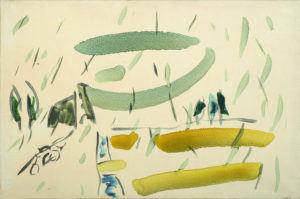
Fina Miralles, Gavasetto a San Pietro lloviendo [Gavasetto at San Pietro raining], 1986, oil on canvas, 27 x 41 cm, courtesy of the artist © Fina Miralles
Unlike the anthropocentric outlook, the vision she embraces is cosmocentric. The cosmic order is primordial and immutable; it is not at the disposition of the human order but the other way around. Humanity is woven into the warp and woof of the universal fabric, a conductive tissue that carries a singular, unchanging energy manifested in diverse and distinct ways but nonetheless connected by a tangle of correspondences that englobes all the chains of being. This cosmological axiom is the subject of her drawings and writings, but she adds her own basic contribution: while connecting with this cultural heritage she opens it to the register of her own truth, the truth of her existence as a woman, the female subjectivity projected in her outlook: “We are a seed; the foetus living inside its mother’s womb is both connected to and protected by the wet, dark space that precedes all birth.”7

Fina Miralles, La alegría de los pájaros por las semillas [The joy of the birds for the seeds], 1986, oil on canvas, 27 x 41 cm, courtesy of the artist ©Fina Miralles
In this quotation the word “womb” is the key that unlocks the symbolic space of meaning because it draws an analogy between Nature and the female act of “bringing into the world”, being a progenitor in both the physiological and spiritual senses. Mothers are not only the source of our bodies; they also provide our first experience with human relations and a way of looking, seeing, speaking and communicating: “Our gaze and our unconscious are created in our mother’s belly; it is the very cradle of our existence. Woman, with their internal, intimate freedom, are indomitable because of their power to conceive, gestate, give birth, raise, provide, love and construct the soul and spirit of every son and every daughter, every home, every day and every night.”8
Thus, her figure, art and writing must be situated in a genealogy of women who, from antiquity through today, have defied the definitions and values inherited from patriarchal culture. Women who live and speak in the female mode and from their personal experience, seeking to give meaning to their life and inhabit the world outside of the hegemonic knowledges of their era, and who take up writing and drawing as tools to actively transform the world and life. The spiritual turn in F. Miralles’ work does not signify a departure from the material, social and political reality of our times; just the opposite. It represents an imperious political option because it implies a way of life based on renunciation, inner truth, and the full and conscious embrace of her birthright as a woman.
For example, in Juan Vicente Aliaga and Patricia Mayayo, eds., Genealogías feministas en el arte español: 1960-2010 (León: MUSAC, 2013); Maite Garbayo, Cuerpos que aparecen. Performance y feminismos en el tardofranquismo (Bilbao: Consonni, 2016); Teresa Grandas, ed., Fina Miralles. Soc totes les que he sigut (exh. cat. Barcelona: MACBA, 2020).
2
Fina Miralles, Del natural (Cadaqués: Ebent’03, 2002; Fina Miralles, Testament vital (Sabadell: Edicions Gràfic Set, 2008).
3
Maia Creus, ed., Fina Miralles. Paraules fèrtils 1972-2017 (Sabadell: Fundació Ars, 2018); M. Lluïsa Faxeda, ed., Germinal. Sobre l’obra de Fina Miralles (Girona: Documenta Universitària, 2020).
4
Fina Miralles. Paraules fèrtils 1972-2017, vol. 1, p. 84.
5
Ibid., p. 124.
6
Ibid., pp. 78-148.
7
Fina Miralles. Paraules fèrtils 1972-2017, vol. 2, p. 87.
8
Fina Miralles. Paraules fèrtils 1972-2017, vol. 4, p. 36.
Maia Creus has a PhD in art history and has taught at the Universitat Autònoma de Barcelona, University of Barcelona and University Ramon Llull. She is a member of the Associació Catalana de Crítics d’Art and the Visionary Women Research Group. Her curatorial work and writings have focused on a reconsideration of contemporary art and a feminist rereading of twentieth-century art history foregrounding women artists.
Maria Lluïsa Faxedas, who also holds a PhD in art history, is a professor at the University of Girona. A member of the Cátedra de Arte y Cultura Contemporáneos, she has published articles and curated exhibitions centred on contemporary art and gender issues.
Maia Creus et Maria Lluïsa Faxedas, "Fina Miralles, from the idea of art to the art of lived experience." In Archives of Women Artists, Research and Exhibitions magazine, . URL : https://awarewomenartists.com/en/magazine/fina-miralles-de-lidee-de-lart-a-lart-de-lexperience/. Accessed 10 July 2025
